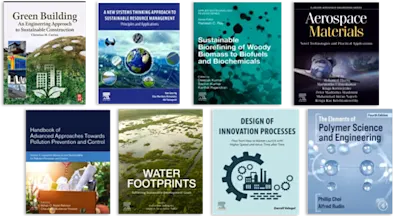SUSTAINABLE DEVELOPMENT
Innovate. Sustain. Transform.
Save up to 30% on top Physical Sciences & Engineering titles!


SUSTAINABLE DEVELOPMENT
Save up to 30% on top Physical Sciences & Engineering titles!

SECTION1 General Physiology
MARIO VAZ
1
Functional Organization of the Human Body and Control of the "Internal Environment"2
The Cell and its Functions3
Genetic Control of Protein Synthesis, Cell Function, and Cell Reproduction4
Transport of Substances Through Cell Membranes5
The Body Fluid Compartments6
Intracellular and Extracellular Fluid Compartments and Edema7
Resting Membrane PotentialSECTION2
Nerve and Muscle PhysiologyMARIO VAZ
8
Stimulus and Excitability of Nerve9
Action Potential of the Nerve10
Propagation of the Nerve Impulse11
Peripheral Nerve Damage12
Neuromuscular Transmission13
Excitation–Contraction Coupling14
Molecular Basis of Skeletal Muscle Contraction15
Chemical Changes During Skeletal Muscle Contraction16
Characteristics of Skeletal Muscle Contraction17
Applied Skeletal Muscle PhysiologySECTION3
Blood and Its ConstituentsANURA KURPAD
18
Introduction to Blood and Plasma Proteins19
Red Blood Cells (Erythrocytes)20
Erythropoiesis21
Hemoglobin22
Anemia and Polycythemia23
Jaundice24
White Blood Cells25
Immunity and Allergy26
Platelets27
Blood Coagulation28
Blood GroupsSECTION4
Cardiovascular PhysiologyMARIO VAZ
29
Organization of the Cardiovascular System30
Properties of Cardiac Muscle31
Cardiac Action Potentials32
Origin and Conduction of the Cardiac Impulse33
The Normal Electrocardiogram 19134
Clinical Applications of the Electrocardiogram35
Cardiac Cycle36
Cardiac Output and Venous Return37
Regulation of Cardiac Output38
Hemodynamics39
Microcirculation40
The Lymphatic System41
Vascular Distensibility of the Venous System42
Determinants of Arterial Blood Pressure43
Short-Term Regulation of Arterial Blood Pressure44
Long-Term Regulation of Arterial Blood Pressure45
Regional Circulation: An Overview46
Coronary Circulation47
Cerebral Circulation48
Splanchnic Circulation49
Fetal and Neonatal Circulation50
Valvular Heart Disease51
Cardiac Failure52
Circulatory ShockSECTION5
Respiratory PhysiologyTONY RAJ
53
Organization of the Respiratory System54
Mechanics of Breathing55
Lung Volumes and Capacities56
Ventilation57
Pulmonary Circulation58
Diffusion of Gases59
Oxygen Transport60
Carbon Dioxide Transport61
Chemical Regulation of Respiration62
Neural Regulation of Respiration63
Respiration in Unusual Environments64
Applied Respiratory PhysiologySECTION6
Gastrointestinal PhysiologyTONY RAJ
65
Organization of the Gastrointestinal System66
Salivary Glands and Secretion67
Gastric Secretions68
Exocrine Pancreas69
Functions of the Liver70
Digestion and Absorption of Carbohydrates71
Digestion and Absorption of Proteins72
Digestion and Absorption of Fats73
Functions of the Large Intestine74
Gastrointestinal Motility75
Physiology of Gastrointestinal DiseasesSECTION7
Renal PhysiologyANURA KURPAD
76
Functional Anatomy of the Kidney77
Urine Formation by the Kidneys: Renal Blood Flow, Glomerular Filtration, and Their Control78
Tubular Function79
Concentration and Dilution of Urine80
Control of Extracellular Fluid Osmolarity and Sodium Concentration81
Renal Regulation of Potassium, Calcium, Phosphate, and Magnesium82
Acid–Base Regulation83
Micturition84
Applied Physiology of the Renal SystemSECTION8
The Endocrine SystemTONY RAJ
85
Organization of the Endocrine System86
Hormone–Receptor Interactions87
Anterior Pituitary Gland and Hypothalamus88
Posterior Pituitary Gland89
Thyroid Gland90
Calcium Homeostasis91
Adrenal Cortex92
Adrenal Medulla93
Endocrine Pancreas and Glucose HomeostasisSECTION9
Reproductive PhysiologyMARIO VAZ
94
Physiological Anatomy of the Male Sexual Organs and Spermatogenesis95
Testosterone and Other Male Sex Hormones96
Female Physiology Before Pregnancy and Female Hormones97
The Sexual Act and Fertilization98
Physiology of Pregnancy99
Parturition and LactationSECTION10
Central Nervous System100
Organization of the Central Nervous SystemPART I
Sensory System
ANURA KURPAD
101
Synapses102
Sensory Receptors103
Somatic Sensory Pathways104
Pain and Temperature105
Somatosensory CortexPART II
Special Senses
ANURA KURPAD
106
Taste and Smell107
Hearing108
Optics of Vision109
The Retina110
Visual Pathways and Central ProcessingPART III
Motor System
ANURA KURPAD
111
Introduction to the Motor System: Spinal Cord112
Cortical and Brainstem Control of Motor Function: The Pyramidal Tract113
Muscle Spindle114
Motor Reflexes115
Regulation of Tone and Posture116
Cerebellum117
Vestibular Apparatus118
Basal GangliaPART IV
Other Functions and Activities of the Brain
MARIO VAZ
119
The Autonomic Nervous System120
Functions of the Hypothalamus121
Cerebrospinal Fluid122
Electroencephalography and Epilepsy123
Sleep124
The Limbic System and Behavior125
Learning and Memory126
Cortical Function, Cerebral Lateralization, and SpeechSECTION11
Miscellaneous TopicsTONY RAJ
127
Components of Energy Expenditure128
Body Temperature Regulation and Cutaneous CirculationIndex
Online PGMEE Patterned Questions
MV
TR